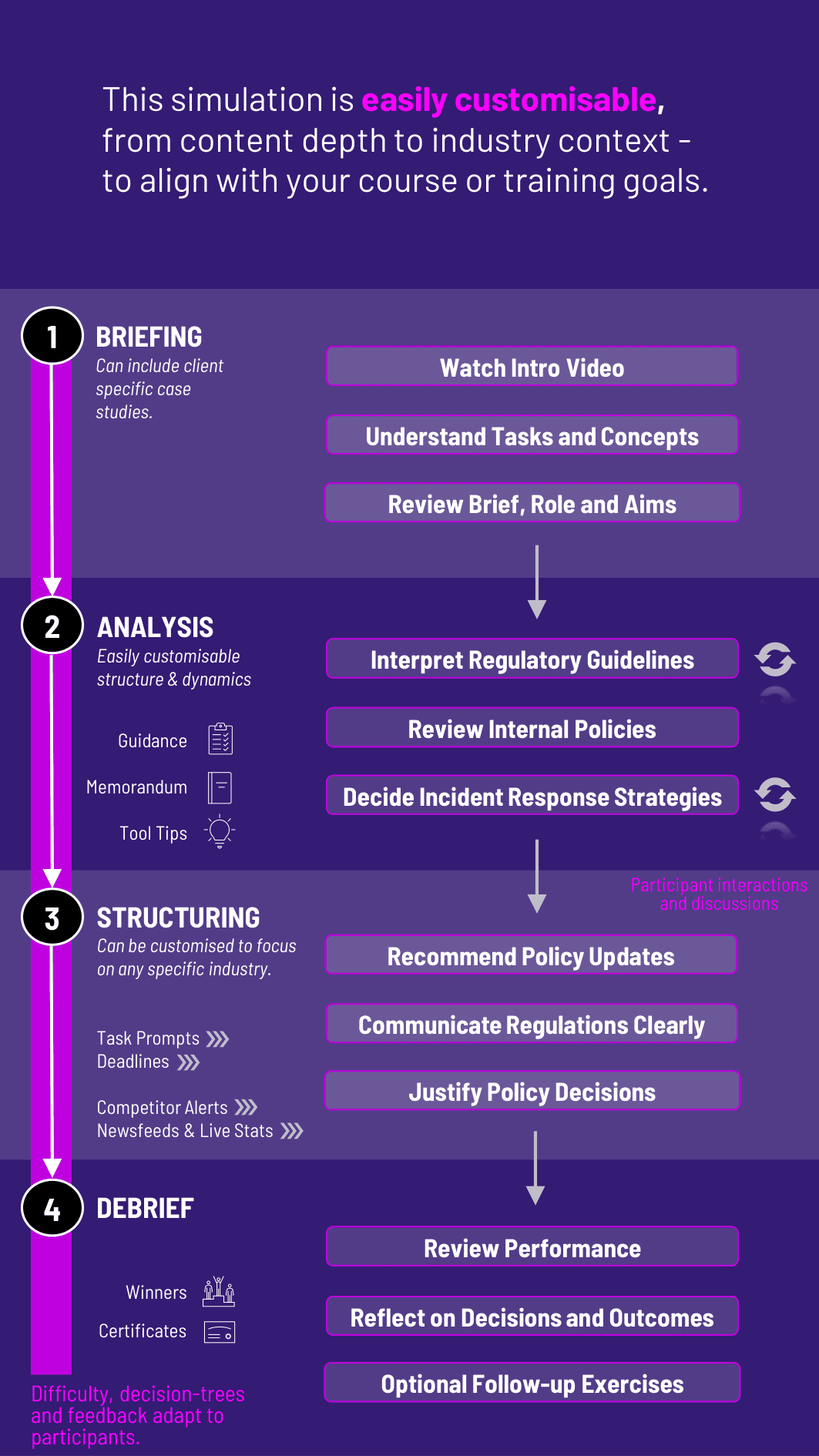
In this Regulatory Compliance in Finance Simulation, participants act as compliance officers navigating financial regulations, managing internal controls, responding to breaches, and aligning business operations with evolving regulatory frameworks.
Protocols: Onboarding, ongoing due diligence, suspicious activity reporting
Regulatory Frameworks: Adherence to various international rules
Internal Controls: Policies, procedures, surveillance, and escalation
Breach Management: Identifying, reporting, remediating internal or client violations
Ethical Decision-Making: Whistleblower protection, grey areas, and personal accountability
Compliance Communication: Training design, stakeholder messaging, documentation
Audit Readiness: Preparing for internal and external reviews
Global Risk Awareness: Adapting policies across jurisdictions with differing standards


Interpret relevant regulatory guidance and identify risks
Review internal policies and flag potential control gaps
Decide on how to respond to compliance incidents or alerts
Balance business needs with regulatory obligations
Recommend training, internal audits, or policy changes
Communicate clearly with regulators, executives, or front-office staff
Justify decisions in a documented audit trail
Respond to real-time feedback or fallout from their choices
By the end of the simulation, participants will be more confident in:
Identifying and responding to compliance risks across financial services
Interpreting and applying complex financial regulations to business scenarios
Managing stakeholder expectations during compliance breaches
Designing risk-based approaches to internal policy and monitoring
Communicating with regulatory bodies under scrutiny
Responding to grey-area dilemmas with professionalism and integrity
Leading proactive compliance programs, not just reactive policing
Embedding a culture of compliance into a growing or pressured firm
Navigating jurisdictional complexity across global financial regulations
Handling sensitive data, whistleblower protection, and reputational issues
This is ideal for learners in finance, law, or risk management roles preparing for careers in compliance, internal audit, or regulatory affairs. The simulation’s flexible structure ensures that these objectives can be calibrated to match the depth, duration, and focus areas of each program, whether in higher education or corporate learning.
1. Receive a Scenario Brief Participants are given a live issue - e.g., a flagged transaction, regulatory notice, employee complaint, or due diligence concern.
2. Assess the Compliance Risk They review the relevant regulation, company policy, and business context to understand potential exposure.
3. Make Strategic Compliance Decisions Participants decide how to respond - e.g., escalate, remediate, notify regulators, revise training, or monitor further.
4. Communicate with Stakeholders They prepare communications to regulators, management, or front-line staff - justifying their rationale and proposing solutions.
5. Receive Feedback and Results The simulation provides real-time feedback based on regulatory outcomes, business impact, and reputational risk.
6. Iterate with New Scenarios Each new round increases in complexity: new geographies, overlapping rules, or deeper business-conflict trade-offs.
Do participants need prior legal or compliance knowledge? No. The simulation includes guided explanations. It’s suitable for beginners and intermediate learners alike.
Can it be tailored for specific sectors? Yes. Scenarios can be adapted for investment banking, wealth management, fintech, or global banking contexts.
Does it include international regulations? Yes. The simulation can include rules from U.S., U.K., EU, APAC, or multi-jurisdictional frameworks.
Can teams collaborate in decision-making? Absolutely. Teams can take roles (e.g., head of compliance, legal advisor, business lead) to reflect real-world tensions.
Are ethical dilemmas included? Yes. Participants must deal with ambiguous or sensitive situations where the right path isn’t always clear.
Is the simulation quantitative? It’s more qualitative, focusing on analysis, policy interpretation, and decision communication.
Can participants practice written communication? Yes. The simulation includes drafting internal memos, incident reports, or regulatory disclosures.
How is performance measured? Based on risk mitigation, communication quality, business alignment, and stakeholder satisfaction.
Is this simulation suitable for corporate training? Yes. It's widely adaptable for financial institutions, regulators, and cross-border firms.
How long does it take? It can run in a 3 - 4 hour duration or be expanded into a multi-session module with layered scenarios.
Risk identification and decision-making
Regulatory understanding and logical application
Communication under scrutiny
Stakeholder awareness and balance
Ethical clarity and professionalism
Written and verbal clarity
Adaptability across scenarios and jurisdictions
Assessment formats may include short memos, team presentations, policy recommendations, or audit readiness reports. Peer and self-assessments can be integrated into corporate learning pathways or university course credit structures.
Join this 20-minute webinar, followed by a Q&A session, to immerse yourself in the simulation.
or
Book a 15-minute Zoom demo with one of our experts to explore how the simulation can benefit you.